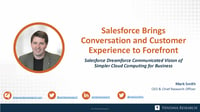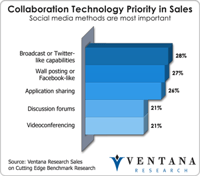Dreamforce has become the largest enterprise software event for businesses in the United States, and it is evident why when looking at it this year. With over 170,000 business and IT professionals attending, Salesforce came to show off upcoming product announcements and innovations. This year's biggest focus was on Einstein Voice (a personalized and intelligent conversational assistant), integration with other platforms, and Salesforce Customer 360. The last of these is the start of an answer...
Read More
Topics:
Salesforce.com,
Customer Experience,
Machine Learning,
Marketing,
Voice of the Customer,
CRM,
Dreamforce,
Sales Performance Management,
SPM,
Digital Technology,
Digital Marketing,
Robotic Process Automation,
AI,
natural language processing
Business software is beginning to undergo a design revolution comparable to the seismic shift from the green screen to the graphical user interface (GUI) that began in the mid-1980s. Three forces are at work. One is the retirement of large numbers of members of the baby-boom generation and the rise of a generation that grew up with computers and computer games from a young age. Also, software and technology vendors have been recognizing the need to “consumerize” business applications as mobile...
Read More
Topics:
Big Data,
Sales Performance,
Salesforce.com,
Supply Chain Performance,
OpenWorld,
Operational Performance,
Business Performance,
Cloud Computing,
Customer & Contact Center,
Financial Performance,
Oracle,
Workforce Performance,
Dreamforce,
finance,
Tidemark,
Business,
design,
development,
GUI
I cover the meat-and-potatoes aspects of corporate computing. I also pay attention to the special needs of midsize companies (by our definition, those with between 100 and 999 employees), which are unlike those of either small business or large corporations. After attending this year’s Dreamforce conference, Salesforce.com’s annual user meeting held this week in San Francisco, I can appreciate how difficult it is for executives and people who work in back office functions to cut through the...
Read More
Topics:
Sales,
Sales Performance,
Salesforce.com,
Social Media,
ERP,
Office of Finance,
CRM customer service,
SMB,
Business Performance,
Cloud Computing,
Customer & Contact Center,
Financial Performance,
Dreamforce,
finance,
Security,
FPM
The annual Salesforce.com Dreamforce conference (Twitter: #DF12), just underway, may be the largest software conference ever, with attendance, physically and on the Internet, expected to be 90,000. Certainly, as one of the largest software events of 2012, this conference will be heavily covered via social media, while under the roof of the Moscone Center and surrounding hotels Salesforce will be demonstrating the power of using social media concepts in the enterprise and combining those...
Read More
Topics:
Sales Performance,
Salesforce.com,
Supply Chain Performance,
Research,
SFDC,
Operational Performance,
Business Analytics,
Business Collaboration,
Business Intelligence,
Business Mobility,
Business Performance,
Cloud Computing,
Customer & Contact Center,
Financial Performance,
Information Applications,
Information Management,
Operational Intelligence,
Workforce Performance,
Dreamforce










